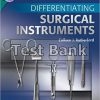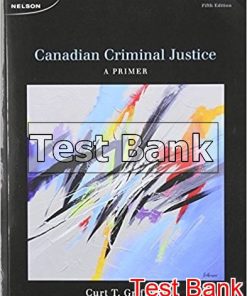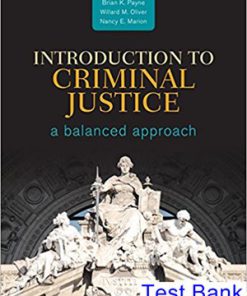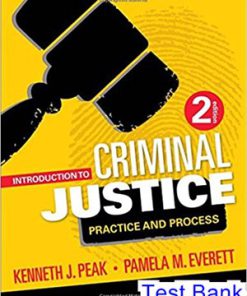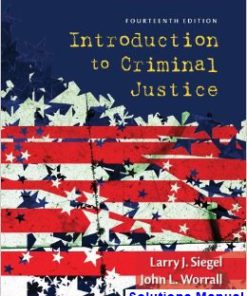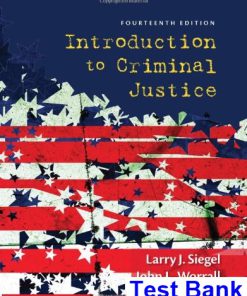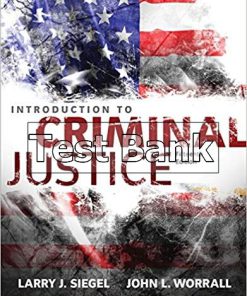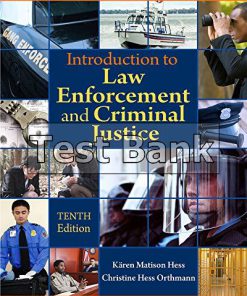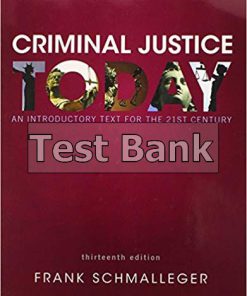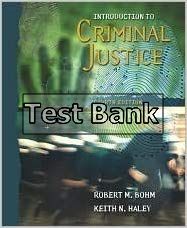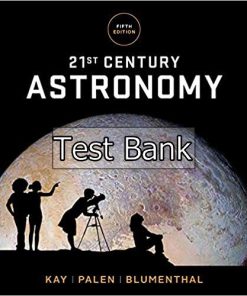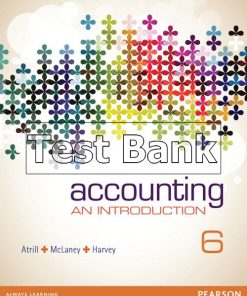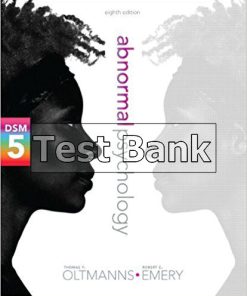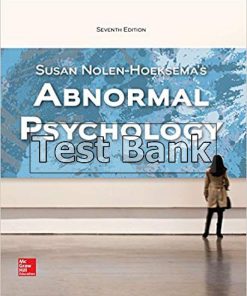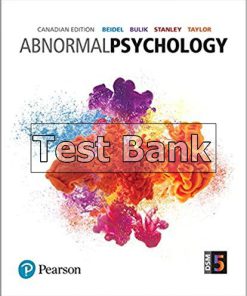Criminal Justice A Brief Introduction 12th Edition Schmalleger Test Bank
$50.00 Original price was: $50.00.$26.50Current price is: $26.50.
Criminal Justice A Brief Introduction 12th Edition Schmalleger Test Bank.
Criminal Justice A Brief Introduction 12th Edition Schmalleger Test Bank
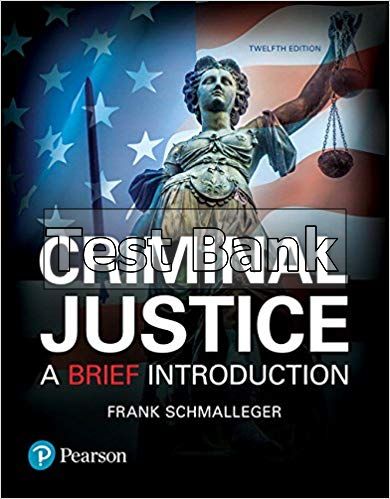
Product details:
- ISBN-10 : 9780134548623
- ISBN-13 : 978-0134548623
- Author: Frank Schmalleger
The gold standard for criminal justice texts
Criminal Justice: A Brief Introduction, Twelfth Edition, offers a contemporary, authoritative look at crime in America with a focus on police, courts, and corrections. To make information resonate with students, Schmalleger asks readers to consider the balance between freedom and security issues and evaluate the strengths and weaknesses of the American justice system as it adapts to cultural, political, and societal changes. A wealth of Internet resources along with author tweets (@schmalleger) extends chapter material and provides up-to-the minute information on this ever-evolving field. Its unifying theme, unmatched timeliness, and coverage of trends and technology make this text the standard by which all other brief texts are judged.
Criminal Justice, Twelfth Edition is also available via Revel™, an interactive learning environment that enables students to read, practice, and study in one continuous experience.
Table contents:
- Preface
- New to the Twelfth Edition
- Instructor Supplements
- REVEL for Criminal Justice: A Brief Introduction, 12e by Schmalleger
- About the Author
- Part 1 Crime in America
- Chapter 1 What is Criminal Justice?
- Learning Objectives
- Introduction
- A Brief History of Crime in America
- The Theme of This Book
- Criminal Justice and Basic Fairness
- American Criminal Justice: System and Functions
- The Consensus Model
- The Conflict Model
- American Criminal Justice: The Process
- Due Process and Individual Rights
- The Role of the Courts in Defining Rights
- The Ultimate Goal: Crime Control through Due Process
- Evidence-Based Practice in Criminal Justice
- The Start of Academic Criminal Justice
- Multiculturalism and Diversity in Criminal Justice
- Summary
- What is Criminal Justice?
- Questions for Review
- Chapter 2 The Crime Picture
- Learning Objectives
- Introduction
- Crime Data and Social Policy
- The Collection of Crime Data
- The UCR/NIBRS Program
- Development of the UCR Program
- The National Incident-Based Reporting System
- Historical Trends
- UCR/NIBRS in Transition
- Part I Offenses
- Murder
- Rape
- Robbery
- Aggravated Assault
- Burglary
- Larceny-Theft
- Identity Theft: A New Kind of Larceny
- Motor Vehicle Theft
- Arson
- Part II Offenses
- The National Crime Victimization Survey
- Comparisons of the UCR and the NCVS
- Special Categories of Crime
- Crime against Women
- The Violence against Women Act (VAWA)
- Crime against the Elderly
- Hate Crime
- Corporate and White-Collar Crime
- Organized Crime
- Gun Crime
- Drug Crime
- Cybercrime
- Terrorism
- Types of Terrorism
- Organization and Scope of Terrorist Groups
- Crime in International Context
- Summary
- The Crime Picture
- Questions for Review
- Chapter 3 Criminal Law
- Learning Objectives
- Introduction
- The Nature and Purpose of Law
- The Rule of Law
- Types of Law
- Criminal Law
- Statutory Law
- Civil Law
- Administrative Law
- Case Law
- General Categories of Crime
- Felonies
- Misdemeanors
- Infractions
- Treason
- Espionage
- Inchoate Offenses
- General Features of Crime
- The Criminal Act (Actus Reus)
- A Guilty Mind (Mens Rea)
- Reckless Behavior and Criminal Negligence
- Strict Liability
- Concurrence
- Other Features of Crime
- Causation
- Harm
- Legality
- Punishment
- Necessary Attendant Circumstances
- Elements of a Specific Criminal Offense
- The Example of Murder
- The Corpus Delicti of a Crime
- Types of Defenses to a Criminal Charge
- Alibi
- Justifications
- Self-Defense
- Defense of Others
- Defense of Home and Property
- Necessity
- Consent
- Resisting Unlawful Arrest
- Excuses
- Duress
- Age
- Mistake
- Involuntary Intoxication
- Unconsciousness
- Provocation
- Insanity
- The M’Naghten Rule
- Irresistible Impulse
- The Durham Rule
- The Substantial-Capacity Test
- The Brawner Rule
- The Insanity Defense and Social Reaction
- The Guilty But Mentally Ill Verdict
- Temporary Insanity
- The Insanity Defense under Federal Law
- The Consequences of an Insanity Ruling
- Diminished Capacity
- Mental Incompetence
- Procedural Defenses
- Entrapment
- Double Jeopardy
- Collateral Estoppel
- Selective Prosecution
- Denial of a Speedy Trial
- Prosecutorial Misconduct
- Police Fraud
- Summary
- Criminal Law
- Questions for Review
- Part 2 Policing
- Chapter 4 Policing: Purpose and Organization
- Learning Objectives
- Introduction
- The Police Mission
- Enforcing the Law
- Apprehending Offenders
- Preventing Crime
- Techniques and Programs
- Predicting Crime
- Preserving the Peace
- Providing Services
- American Policing Today: From the Federal to the Local Level
- Federal Agencies
- The FBI
- The FBI and Counterterrorism
- State Agencies
- Local Agencies
- Fusion Centers
- Private Protective Services
- International Police Agencies
- Interpol
- Europol
- Police Administration
- Police Organization and Structure
- Chain of Command
- Policing Epochs and Styles
- Policing Epochs
- The Watchman Style of Policing
- The Legalistic Style of Policing
- The Service Style of Policing
- Police–Community Relations
- Team Policing
- Community Policing
- Community Policing and Antiterrorism
- Critique of Community Policing
- Evidence-Based Policing
- The Kansas City Experiment
- History
- Effects
- Evidence-Based Policing Today
- Discretion and the Individual Officer
- Summary
- Policing: Purpose and Organization
- Questions for Review
- Chapter 5 Policing: Legal Aspects
- Learning Objectives
- Introduction
- The Abuse of Police Power
- A Changing Legal Climate
- Individual Rights
- Checks and Balances
- Due-Process Requirements
- Search and Seizure
- The Exclusionary Rule
- Problems with Precedent
- The Fruit of the Poisonous Tree Doctrine
- Searches Incident to Arrest
- Judicial Philosophy and the U.S. Supreme Court
- The Warren Court (1953–1969)
- The Burger Court (1969–1986)
- The Rehnquist Court (1986–2005)
- The Roberts Court (2005–Today)
- Good-Faith Exceptions to the Exclusionary Rule
- The Plain-View Doctrine
- Emergency Searches of Property and Emergency Entry
- Anticipatory Warrants
- Detention and Arrest
- Searches Incident to Arrest
- Emergency Searches of Persons
- Vehicle Searches
- Roadblocks and Motor Vehicle Checkpoints
- Watercraft and Motor Homes
- Suspicionless Searches
- High-Technology Searches
- The Intelligence Function
- Informants
- Police Interrogation
- Physical Abuse
- Inherent Coercion
- Psychological Manipulation
- The Right to a Lawyer at Interrogation
- Suspect Rights: The Miranda Decision
- Waiver of Miranda Rights by Suspects
- Inevitable-Discovery Exception to Miranda
- Public-Safety Exception to Miranda
- Miranda and the Meaning of Interrogation
- Gathering of Special Kinds of Nontestimonial Evidence
- The Right to Privacy
- Body-Cavity Searches
- Electronic Eavesdropping
- Minimization Requirement for Electronic Surveillance
- The Electronic Communications Privacy Act of 1986
- The Telecommunications Act of 1996
- The USA PATRIOT Act of 2001
- Cybersecurity Information Sharing Act (CISA)
- Electronic and Latent Evidence
- Summary
- Policing: Legal Aspects
- Questions for Review
- Chapter 6 Policing: Issues and Challenges
- Learning Objectives
- Introduction
- Police Personality and Culture
- Corruption and Integrity
- Money—The Root of Police Evil?
- Building Police Integrity
- Drug Testing of Police Employees
- The Dangers of Police Work
- Violence in the Line of Duty
- Risk of Disease and Infected Evidence
- Stress and Fatigue among Police Officers
- Stress Reduction
- Officer Fatigue
- Terrorism’s Impact on Policing
- The FBI’s Joint Terrorism Task Forces
- Intelligence-Led Policing and Antiterrorism
- Information Sharing and Antiterrorism
- The National Criminal Intelligence Sharing Plan
- Police Civil Liability
- Common Sources of Civil Suits
- Federal Lawsuits
- Racial Profiling and Biased Policing
- Racial Profiling
- Racially Biased Policing
- Police Use of Force
- Deadly Force
- Less-Lethal Weapons
- Professionalism and Ethics
- Education and Training
- Recruitment and Selection
- Ethnic and Gender Diversity in Policing
- Women as Effective Police Officers
- Summary
- Policing: Issues and Challenges
- Questions for Review
- Part 3 Adjudication
- Chapter 7 The Courts
- Learning Objectives
- Introduction
- History and Structure of the American Court System
- The State Court System
- The Development of State Courts
- State Court Systems Today
- State Trial Courts
- State Appellate Courts
- State Court Administration
- Dispute-Resolution Centers and Specialized Courts
- The Federal Court System
- U.S. District Courts
- U.S. Courts of Appeal
- The U.S. Supreme Court
- The Supreme Court Today
- Pretrial Activities
- The First Appearance
- Pretrial Release
- Bail
- Alternatives to Bail
- Release on Recognizance (ROR)
- Property Bonds
- Deposit Bail
- Conditional Release
- Third-Party Custody
- Unsecured Bonds
- Signature Bonds
- Pretrial Release and Public Safety
- The Grand Jury
- The Preliminary Hearing
- Arraignment and the Plea
- Plea Bargaining
- Summary
- The Courts
- Questions for Review
- Chapter 8 The Courtroom Work Group and the Criminal Trial
- Learning Objectives
- Introduction
- The Courtroom Work Group: Professional Courtroom Actors
- The Judge
- The Role of the Judge
- Judicial Selection
- Judicial Qualifications
- The Prosecuting Attorney
- Prosecutorial Discretion
- The Abuse of Discretion
- The Prosecutor’s Professional Responsibility
- The Defense Counsel
- Private Attorneys
- Court-Appointed Counsel
- Assigned Counsel
- Public Defenders
- Contractual Arrangements
- Problems with Indigent Defense
- The Ethics of Defense
- The Bailiff
- Trial Court Administrators
- The Court Reporter
- The Clerk of Court
- Expert Witnesses
- Outsiders: Nonprofessional Courtroom Participants
- Lay Witnesses
- Jurors
- The Victim
- The Defendant
- Spectators and the Press
- The Criminal Trial
- Procedure
- Nature and Purpose of the Criminal Trial
- Stages in a Criminal Trial
- Trial Initiation
- Jury Selection
- Challenges in Jury Selection
- Jury Selection and Race
- Opening Statements
- Presentation of Evidence
- Types of Evidence
- Evaluation of Evidence
- Testimony of Witnesses
- Children as Witnesses
- The Hearsay Rule
- Closing Arguments
- Judge’s Charge to the Jury
- Jury Deliberations and the Verdict
- Deliberations Process
- Problems with the Jury System
- Summary
- The Courtroom Work Group and the Criminal Trial
- Questions for Review
- Chapter 9 Sentencing
- Learning Objectives
- Introduction
- The Philosophy and Goals of Criminal Sentencing
- Retribution
- Incapacitation
- Deterrence
- Rehabilitation
- Restoration
- Indeterminate Sentencing
- Explanation of Indeterminate Sentencing
- Critiques of Indeterminate Sentencing
- Structured Sentencing
- Federal Sentencing Guidelines
- Federal Guideline Provisions
- Plea Bargaining under the Guidelines
- The Legal Environment of Structured Sentencing
- Three-Strikes Laws
- Mandatory Sentencing
- Sentencing and Today’s Prison Crisis
- Innovations in Sentencing
- Questions about Alternative Sanctions
- The Presentence Investigation
- The Victim—Forgotten No Longer
- Victims’ Rights
- Victim-Impact Statements
- Modern Sentencing Options
- Sentencing Rationales
- Sentencing Practices
- Fines
- Death: The Ultimate Sanction
- Habeas Corpus Review
- Opposition to Capital Punishment
- The Death Penalty and Innocent People
- Death Penalty and Deterrence
- Death Penalty and Discrimination
- Justifications for Capital Punishment
- The Courts and the Death Penalty
- The Future of the Death Penalty
- Summary
- Sentencing
- Questions for Review
- Part 4 Corrections
- Chapter 10 Probation, Parole, and Community Corrections
- Learning Objectives
- Introduction
- What Is Probation?
- The Extent of Probation
- Probation Conditions
- The Federal Probation System
- What Is Parole?
- The Extent of Parole
- Parole Conditions
- Federal Parole
- Probation and Parole: The Pluses and Minuses
- Advantages of Probation and Parole
- Disadvantages of Probation and Parole
- The Legal Environment
- The Job of Probation and Parole Officers
- Job Descriptions
- The Challenges of the Job
- Intermediate Sanctions
- Split Sentencing
- Shock Probation and Shock Parole
- Shock Incarceration
- Mixed Sentencing and Community Service
- Intensive Probation Supervision
- Home Confinement and Remote Location Monitoring
- The Future of Probation and Parole
- Changes in Reentry Policies
- The Reinvention of Probation and Evidence-Based Practices
- Summary
- Probation, Parole, and Community Corrections
- Questions for Review
- Chapter 11 Prisons and Jails
- Learning Objectives
- Introduction
- A Brief History of Prisons
- Prisons Today
- Prisoners Today
- Overcrowding
- Selective Incapacitation: A Contemporary Strategy to Reduce Prison Populations
- Security Levels
- Prison Classification Systems
- The Federal Prison System
- The Growth of Federal Prisons
- Recent Improvements
- Jails
- Women and Jail
- The Growth of Jails
- New Generation Jails
- Jails and the Future
- Private Prisons
- Summary
- Prisons and Jails
- Questions for Review
- Chapter 12 Prison Life
- Learning Objectives
- Introduction
- Research on Prison Life: Total Institutions
- The Male Inmate’s World
- The Evolution of Prison Subcultures
- The Functions of Prison Subcultures
- Prison Lifestyles and Inmate Types
- Homosexuality and Sexual Victimization in Prison
- The Female Inmate’s World
- Sexual Victimization of Women Prisoners
- Parents in Prison
- Gender-Responsiveness
- Institutions for Women
- Social Structure in Women’s Prisons
- Types of Female Inmates
- Violence in Women’s Prisons
- The Staff World
- Facts and Figures
- The Professionalization of Corrections Officers
- Security Threat Groups and Prison Riots
- Prisoners’ Rights
- Issues Facing Prisons Today
- HIV/AIDS
- Geriatric Offenders
- Inmates with Mental Illness and Intellectual Disabilities
- Terrorism
- Summary
- Prison Life
- Questions for Review
- Part 5 The Juvenile Justice System
- Chapter 13 Juvenile Justice
- Learning Objectives
- Introduction
- Juvenile Justice Throughout History
- Earliest Times
- The Juvenile Court Era
- Categories of Children in the Juvenile Justice System
- The Legal Environment
- Legislation Concerning Children and Justice
- The Legal Rights of Juveniles
- The Juvenile Justice Process Today
- Adult and Juvenile Justice Compared
- How the System Works
- Intake and Detention Hearings
- Detention Hearing
- Preliminary Hearing
- Transfer Hearing
- Adjudication
- Disposition
- Secure Institutions for Juveniles
- Characteristics of Juveniles in Confinement
- Overcrowding in Juvenile Facilities
- Postadjudicatory Review
- Trends in Juvenile Justice
- Summary
- Juvenile Justice
- Questions for Review
- Appendix A
- Appendix B
- List of Acronyms
- Glossary
- Notes
- Index
People also search:
Criminal Justice A Brief Introduction
Criminal Justice A Brief Introduction 12th
Criminal Justice A Brief Introduction 12th pdf
Criminal Justice A Brief Introduction 13th
Criminal Justice A Brief Introduction test bank
Instant download after Payment is complete
You may also like…
Humanities and Social Sciences
Introduction to Criminal Justice 14th Edition Siegel Solutions Manual
Humanities and Social Sciences
Introduction to Criminal Justice 14th Edition Siegel Test Bank
Solutions Manual
Introduction to Criminal Justice 15th Edition Siegel Test Bank
Solutions Manual
Criminal Justice Today An Introductory Text for the 21st Century 13th Edition Schmalleger Test Bank



